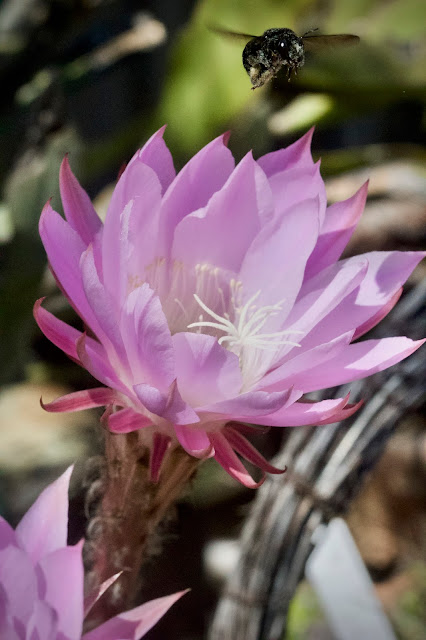 |
| Carpenter Bee hovers above nectar pool looking out at lens |
The poem argues a fulfilled life is one that pauses to observe, to n.b., to dar cuenta. At 16, there’s a lifetime ahead that we shall fill up with cares and regrets. At 75, dar cuenta, and allow Davies his old man’s sentimentality.
What is this life if, full of care,
We have no time to stand and stare.
No time to stand beneath the boughs
And stare as long as sheep or cows.
No time to see, when woods we pass,
Where squirrels hide their nuts in grass.
No time to see, in broad daylight,
Streams full of stars, like skies at night.
No time to turn at Beauty's glance,
And watch her feet, how they can dance.
No time to wait till her mouth can
Enrich that smile her eyes began.
A poor life this if, full of care,
We have no time to stand and stare.
What indeed, is this Plague-time, if not an opportunity to use a super power, the power to stop time by standing, or sitting, and staring. For me, I sit staring at a spot in the air waiting for a bee to fill it, and when it does, I will stop time. In the meanwhile, time has little relevance, I'm bound to a bee's randomness. I like that.
 |
| Echinopsis blooms in multiples |
 |
Bumblebee digs in for a hearty fill-up.
|
The bee works that sweet meal. Several times she hits the flower, rises, returns, I miss the entry. I stand and stare, count my breaths and hum a waiting song.
 |
| Bumblebee singing "they had to carry harry to the ferry..." (Cal Drinking song) |
Sated, the bee makes her way out of the pool, careful not to pull too hard on the flexible petal she uses to millimeter her route out, the bee pulls and turns and maneuvers, finally she has fully emerged and takes a breather on the soft bed of anthers. I take the foto.
Freed from the confining forest, she whirls about to face the sky. Making her way to the edge of the trumpet’s mouth, the gloriously beautiful bee looks at me with a satisfied grin, and lifts off the Yellow carpet. I steady the tripod and get to work.
“Go to the Violet Echinopsis” my mind chants as I work the tripod head. Tormenting me, the Carpenter Bee floats and flits toward the violet beauty I’m targeting. I frame a gorgeous still life; with the bee, a vividly vital image. Come, bee, find the spot.
The giant bee noses into yesterday’s now-fading violet blossom. I hold my breath. I’m rapidly setting the tripod and focusing the lens on the next flower in line. Got it, sharp, framed, focused. All I need is the bee directly above the stigma.
I have set the shutter speed at 1/2000 of a second. Even when the bee flies parallel to the lens, the speed should freeze the wings in mid-beat. Bees flying away from the lens diving toward the nectar should display the veins of the open wings, at 1/2000--provided the bee is in the right spot, which is a cube 3" by 3" by 3" with this good lens at this close to the object.
I have the sensitivity set to ISO1600. At the speed I use, my aperture will provide the 3" depth of focus above the center of the trumpet and stop wings. Outside that range, the bee is a blurry blot. Failure. I take several of these too soon grabs, and lots of too lates. 1/2000 isn't fast enough and the wings partially display detail.
The beehemoth from the Yellow delight now floats toward the leading edge of my target flower. Where I am not focused, so I must stand and stare, like the poet says. Now the bee catches a scent of the delicately faint violet nectar. The gigantic bee so photogenic, its buzzing wings so loud, floats upward. My finger lightly presses the remote. The receiver lights green, shutter ready to click at near light-speed. The bee sniffs, floats back unimpressed. Once you’ve had Yellow, she must have said. The shiny black abdomen catches the sun and with the bright spot on her rump, she turns and I hear her buzz doppler off down the driveway.
I have time tomorrow to sit in the same place, and stare. The Violet Echinopsis plants have a single bud remaining. One more flower tomorrow, one more opportunity to stop and stare. Hey, big bumblebee, spend a little time with me. As it turns out, a shiny black Carpenter Bee visits and lets me stand and stare. It is the final Violet Echinopsis blossom of the year.
 |
| The last Violet Echinopsis of the season. |



No comments:
Post a Comment